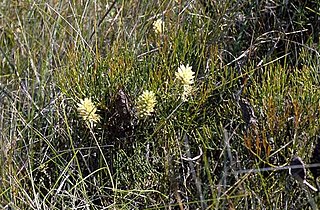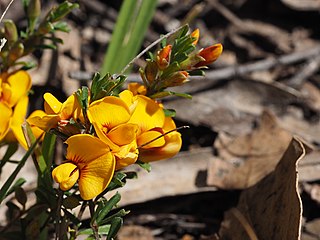
Bursaria is a genus of eight species of flowering plants in the family Pittosporaceae and is endemic to Australia. They are shrubs or slender trees, often with spiny branches and have simple leaves, relatively small flowers with five sepals, five petals and five stamens, and fruit that is a flattened, thin-walled capsule.

Petrophile shirleyae is a species of flowering plant in the family Proteaceae and is endemic to Queensland. It is a shrub with pinnate, needle-shaped, sharply-pointed leaves, and narrow oval heads of silky-hairy white to pale cream-coloured flowers.

Prostanthera spinosa, commonly known as spiny mintbush, is a shrub that is endemic to south-eastern Australia. It has mauve to white flowers, spiny stems and aromatic foliage.

Bossiaea obcordata, commonly known as spiny bossiaea, is a species of flowering plant in the family Fabaceae and is endemic to south-eastern continental Australia. It is an erect, rigid shrub with spiny branches, heart-shaped to egg-shaped with the narrower end towards the base, and yellow and purplish-brown flowers.

Leptospermum oligandrum is a species of erect, spreading shrub that is endemic to the south-west of Western Australia. It has broadly egg-shaped to wedge-shaped leaves, white flowers arranged singly or in groups of up to three on the ends of short side branches and fruit that fall from the plant shortly after the seeds are released.
Leptospermum roei is a species of spreading shrub that is endemic to the southwest of Western Australia. It has thin, fibrous bark, long egg-shaped to narrow wedge-shaped leaves, white or pink flowers and small fruit that are shed with the seeds.

Bossiaea brownii is a species of flowering plant in the family Fabaceae and is endemic to eastern Queensland. It is an erect shrub with egg-shaped leaves and yellow flowers with red markings.

Bossiaea tasmanica is a species of flowering plant in the family Fabaceae and is endemic to Tasmania. It is a prostrate or low-lying shrub with spiny branches, elliptic to egg-shaped with the narrower end towards the base, and yellow and red to pink flowers.

Boronia squamipetala is a species of plant in the citrus family, Rutaceae, and is endemic to Queensland, Australia. It is an erect shrub with pinnate leaves with between five and thirteen elliptic leaflets, and green to white, four-petalled flowers with hairy backs.

Leptospermum parvifolium, commonly known as lemon-scented tea-tree, is a species of shrub that is endemic to eastern Australia. It has thin, rough bark, egg-shaped leaves with the narrower end towards the base, white or pink flowers, and fruit with the remains of the sepals attached but that is shed when the seeds are mature.

Leptospermum sericatum is a species of erect shrub that is endemic to Queensland. It has thin, firm bark, narrow egg-shaped to elliptical leaves, white or pink flowers arranged usually singly on side shoots and fruit that falls from the plant when the seeds are released.

Bursaria occidentalis is a species of flowering plant in the family Pittosporaceae and is endemic to Western Australia. It is a spiny tree or shrub with egg-shaped adult leaves, flowers with relatively small, hairy sepals and five spreading creamy-white petals, and inflated capsules.

Pultenaea foliolosa, commonly known as the small-leaf bush-pea, is a species of flowering plant in the family Fabaceae and is endemic to eastern Australia. It is an erect to low-lying shrub with elliptic to oblong leaves that are concave on the upper surface, and yellow to orange and reddish-brown flowers.

Bossiaea carinalis is a species of flowering plant in the family Fabaceae and is endemic to eastern Queensland. It is an erect shrub with narrow egg-shaped to lance-shaped leaves and pink to red and yellow flowers.

Pultenaea microphylla is a species of flowering plant in the family Fabaceae and is endemic to eastern Australia. It is an erect to prostrate shrub with narrow egg-shaped leaves with the narrower end towards the base, and clusters of up to ten yellow to red flowers with reddish markings.
Bursaria calcicola is a species of flowering plant in the family Pittosporaceae and is endemic to a restricted area near Wombeyan Caves in New South Wales. It is a spiny, hairy, erect or sprawling shrub with clustered, narrowly elliptic to egg-shaped leaves, white flowers with triangular sepals, cream-coloured petals and flattened fruit.
Bursaria cayzerae is a species of flowering plant in the family Pittosporaceae and is endemic to the North Coast of New South Wales. It is a sparsely-branched shrub with spiny branches, narrowly elliptic leaves, flowers with five glabrous sepals, spreading white petals and five stamens, and flattened fruit.

Bursaria incana, commonly known as prickly pine, box thorn, native box, native olive and mock orange, is a species of flowering plant in the family Pittosporaceae and is endemic to northern Australia. It is a tall shrub or small, sparse tree with softly-hairy foliage, heart-shaped leaves with the narrower end towards the base, leafy groups of white flowers with five spreading sepals, five spreading petals, and flattened fruit.

Bursaria longisepala is a species of flowering plant in the family Pittosporaceae and is endemic to New South Wales. It is a spiny, sprawling shrub with narrowly elliptic leaves clustered around spiny side-shoots, flowers with relatively large sepals, five spreading white petals and five stamens, and concave fruit.

Bursaria tenuifolia is a species of flowering plant in the family Pittosporaceae and is endemic to north-eastern Queensland. It is a shrub or spindly tree with elliptic to rhombic adult leaves, spiny foliage when young, flowers with five whitish petals, and slightly flattened, papery fruit.


















